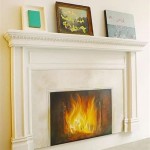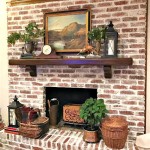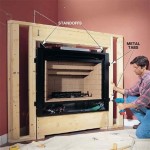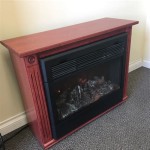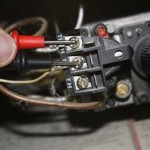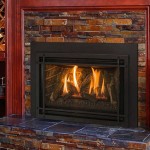Building an Outdoor Fireplace Grill: A Comprehensive Guide
An outdoor fireplace grill combines the ambiance of a traditional fireplace with the functionality of a barbecue grill, offering a unique focal point for outdoor living spaces and a versatile cooking appliance. Constructing such a structure requires careful planning, adherence to safety regulations, and a solid understanding of materials and construction techniques.
This article provides a comprehensive guide to building an outdoor fireplace grill, covering essential aspects from initial design considerations to final construction steps. It aims to equip the reader with the knowledge required to undertake this project successfully or to make informed decisions when hiring a professional.
Planning and Design Considerations
The initial planning phase is crucial for a successful outdoor fireplace grill project. This phase involves assessing the available space, considering local building codes and regulations, and developing a detailed design plan. A well-thought-out plan mitigates potential cost overruns and construction delays.
Space Assessment: The first step is to evaluate the available space. This includes measuring the dimensions of the intended location and considering the surrounding landscape. The size of the fireplace grill should be proportionate to the yard or patio. Sufficient space is needed not only for the structure itself but also for comfortable seating and safe movement around the fire. Factors like proximity to property lines, trees, and other structures must be assessed to ensure compliance with local regulations and to minimize fire hazards.
Building Codes and Regulations: Before commencing any construction, it is imperative to consult local building codes and regulations. These codes often dictate specific requirements related to setbacks from property lines, permissible materials, chimney height, and fire safety measures. Failure to comply with these regulations can result in costly fines and the need to dismantle or modify the structure. Obtaining necessary permits is a critical step and often requires submitting detailed design plans for approval.
Design and Material Selection: The design of the outdoor fireplace grill should reflect the aesthetic preferences of the homeowner while also considering functionality and durability. Common design styles range from rustic stone fireplaces to modern brick structures. The choice of materials significantly impacts the overall look and longevity of the fireplace. Common materials include brick, stone, concrete blocks, and refractory materials for the firebox. Refractory materials are essential for withstanding the high temperatures within the firebox and preventing structural damage. The design should also incorporate features such as a chimney for efficient smoke ventilation, a firebox with adequate depth and width, and a grilling surface or cooking grate.
Drafting a Detailed Plan: A detailed plan is essential before starting the construction. This plan should include precise dimensions, material specifications, and construction steps. It can be professionally drafted or created using specialized software. The plan should include elevations, sections, and detailed drawings of critical components such as the firebox, chimney, and grilling surface. A well-detailed plan serves as a roadmap for the construction process and ensures that all aspects of the project are properly addressed.
Construction Process: Step-by-Step Guide
The construction process involves several stages, starting with site preparation and foundation laying, followed by building the firebox and chimney, and finally, installing the grilling components. Each stage requires meticulous attention to detail and adherence to best practices to ensure a safe and functional structure.
Site Preparation and Foundation: The first step in the construction process is site preparation. This involves clearing the area of any vegetation, debris, and topsoil. A stable and level foundation is critical for the structural integrity of the fireplace grill. Typically, a concrete slab foundation is used. The depth and dimensions of the foundation depend on the size and weight of the fireplace. It is crucial to ensure that the foundation extends below the frost line to prevent cracking and shifting due to freeze-thaw cycles. Reinforcement with rebar is often necessary to enhance the strength and durability of the foundation. After pouring the concrete, it should be allowed to cure properly before proceeding with the next step.
Building the Firebox: The firebox is the heart of the fireplace grill and must be constructed using refractory materials capable of withstanding high temperatures. Refractory bricks or firebricks are commonly used for this purpose. The firebox should be designed with adequate depth and width to accommodate a sufficient fire. The joints between the bricks should be filled with refractory mortar to create a tight seal and prevent heat loss. The firebox can be built using a variety of bonding patterns, such as running bond or herringbone bond, depending on the desired aesthetic. It is important to ensure that the firebox is properly insulated to prevent heat from transferring to the surrounding structure.
Constructing the Chimney: The chimney is responsible for venting smoke and combustion gases away from the cooking area. It must be designed to create sufficient draft to ensure efficient smoke removal. The chimney can be constructed using brick, stone, or concrete blocks. The interior of the chimney should be lined with fireclay flue liners to protect the chimney structure from heat and corrosion. The height of the chimney is critical for creating adequate draft. Local building codes often specify minimum chimney heights based on the size of the firebox and the proximity to surrounding structures. A chimney cap should be installed to prevent rain and debris from entering the chimney and to improve draft.
Installing the Grilling Components: Once the firebox and chimney are complete, the grilling components can be installed. This typically includes a grilling grate or cooking surface made of stainless steel or cast iron. The grate should be adjustable to allow for varying the distance from the heat source. Some designs incorporate additional features such as side burners, warming racks, or rotisserie attachments. The grilling components should be securely mounted within the firebox and must be easily removable for cleaning and maintenance.
Materials and Tools
Selecting appropriate materials and having the right tools are critical for a successful outdoor fireplace grill construction project. This section outlines the essential materials and tools required for each stage of the construction process.
Essential Materials:
- Concrete: Used for the foundation. The amount needed will depend on the size of the planned foundation.
- Rebar: Used to reinforce the concrete foundation.
- Brick, Stone, or Concrete Blocks: Used for the main structure of the fireplace. Brick and stone offer aesthetic appeal, while concrete blocks are a more cost-effective option.
- Refractory Bricks or Firebricks: Essential for lining the firebox to withstand high temperatures.
- Refractory Mortar: Used to bond the refractory bricks together and create a heat-resistant seal.
- Fireclay Flue Liners: Used to line the interior of the chimney and protect it from heat and corrosion.
- Grilling Grate or Cooking Surface: Typically made of stainless steel or cast iron.
- Chimney Cap: Used to prevent rain and debris from entering the chimney.
- Gravel or Crushed Stone: Used for drainage and to create a stable base for the foundation.
Essential Tools:
- Shovels and Wheelbarrow: Used for site preparation and moving materials.
- Concrete Mixer: Used to mix concrete for the foundation.
- Level: Used to ensure that the foundation and structure are level.
- Masonry Saw: Used to cut bricks, stones, and concrete blocks.
- Trowel: Used to apply mortar.
- Rubber Mallet: Used to tap bricks into place.
- Measuring Tape: Used for accurate measurements.
- Square: Used to ensure that corners are square.
- Safety Glasses and Gloves: Essential for protecting eyes and hands during construction.
- Mortar Mixer (Optional): Can be used to mix mortar more efficiently.
- Angle Grinder with Diamond Blade (Optional): Can be used for cutting stones and bricks with greater precision.
Investing in high-quality materials and tools ensures that the outdoor fireplace grill will be durable and long-lasting. It is also important to follow safety precautions when using power tools and handling heavy materials.
Safety Precautions and Maintenance
Safety and proper maintenance are paramount when building and using an outdoor fireplace grill. Adhering to safety guidelines and implementing a regular maintenance schedule ensures the longevity and safe operation of the structure.
Fire Safety: Before using the fireplace grill, ensure that it is located in a safe area, away from flammable materials such as dry leaves, overhanging branches, and wooden structures. Keep a fire extinguisher or water hose readily available in case of emergencies. Never leave a fire unattended and always supervise children and pets when the fireplace is in use. Use caution when handling hot surfaces and wear appropriate protective gear such as heat-resistant gloves. Ensure that the chimney is free of obstructions to prevent smoke from backing up into the cooking area. Regularly inspect the firebox and chimney for cracks or damage and make necessary repairs promptly.
Structural Safety: Regularly inspect the structure for signs of deterioration, such as cracks in the foundation, loose bricks or stones, and crumbling mortar. Promptly repair any structural damage to prevent further deterioration and ensure the stability of the fireplace grill. Pay particular attention to the firebox and chimney, as these components are exposed to high temperatures and are more susceptible to damage. If significant structural damage is detected, consult with a qualified masonry contractor for professional assessment and repair.
Cleaning and Maintenance: Regular cleaning and maintenance are essential for preserving the appearance and functionality of the outdoor fireplace grill. Remove ashes and debris from the firebox after each use to prevent buildup and corrosion. Clean the grilling grate or cooking surface regularly to remove food residue and grease. Inspect the chimney for creosote buildup and schedule professional chimney cleaning as needed. Apply a sealant to the exterior of the structure to protect it from the elements. Replace any damaged or worn-out components promptly to prevent further damage. With proper care and maintenance, an outdoor fireplace grill can provide years of enjoyment and enhance the outdoor living space.

Diy Building Outdoor Fireplace With Smoker And Grill Bbq

37 Diy Outdoor Fireplace And Fire Pit Ideas Godiygo Com Oven Backyard

Outdoor Fire Pit Fireplace Design Build Professional Install Oasis Living

Outdoor Fireplace Plans With Bbq Grill 3 X10

Easy Diy Fire Pit Kit With Grill Redhead Can Decorate

Outdoor Oven Fireplace Round Grove S Fiesta Patio Furnishings

How To Build An Outdoor Fireplace

Stone Age Manufacturing 18 Inch Veranda Diy Outdoor Fireplace Kit

Outdoor Fireplace Kits Masonry Stone

Large Fire Brick Charcoal Bbq Rotisserie With Stone Buschbeck Usa

